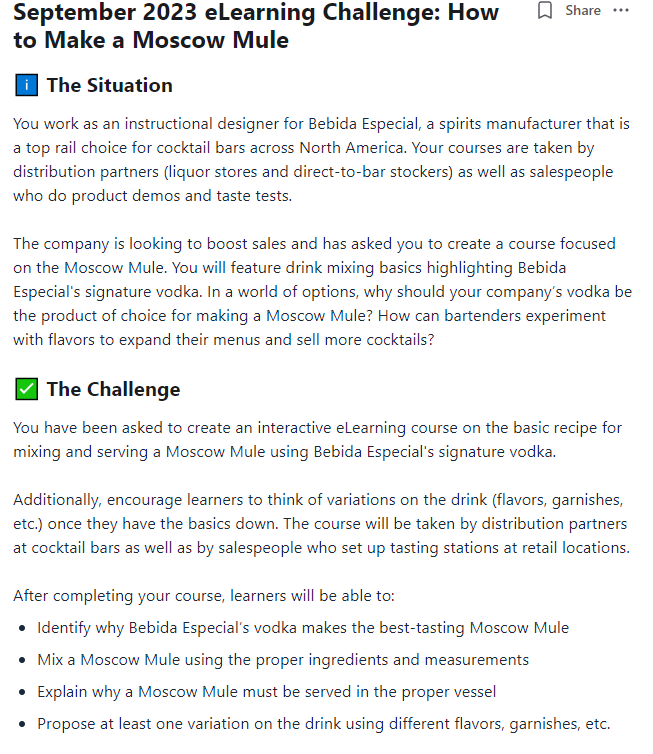Crafting a Mule Branching Scenario
Client: Concept Project (Tim Slade’s September 2023 Monthly Challenge)
Year: 2024
Categories: eLearning
Skills: Instructional Design, eLearning Development, Graphic Design, Animation
Tools: Articulate Storyline 360, Adobe Illustrator, Figma, Twine, Vyond, WellSaid Labs
The Concept
This project was created as part of Tim Slade’s September 2023 monthly challenge. The prompt was to create an interactive course focused on making a Moscow Mule to help sell more of the fictional company’s signature vodka.
The audience was already established (distribution partners and sales reps) and the learning objectives were provided.
My Approach
What I found interesting about this prompt was that it combined multiple facets - a seemingly easy topic (making a well-known cocktail) with a marketing bent (using that cocktail to sell more vodka). I knew that I needed to hit the right mix of marketing (how should the sales rep be marketing the product) and instruction (how the cocktail is made).
I decided to use animated videos to first introduce how the product should be marketed and then follow those up with a branching scenario that would allow learners to practice their approach with a client. Within each of these sections is an opportunity to make a Moscow Mule.
I also knew I wanted to be mindful of those who already know how to make a Mule. Therefore, I decided that if the learner makes the Mule correctly without referencing the recipe during the first section, they would be able to skip it in the second section.
The Challenges
This course presented a number of challenges. I initially questioned if training was the right answer to the challenge presented (increasing sales by showcasing the Signature Vodka through a Moscow Mule). After all, most people in the liquor industry probably already know how to make a mule, and if they don’t, they can simply reference the recipe. However, I also realized that this challenge was about more than just crafting a Mule; it was about properly marketing the vodka to potential buyers. Once I reframed my perspective and saw it as a sales training, I began to see the potential of the course.
This course was also a challenge visually. The colors specified in the brand guide were red and black. I found the red to be jarring when used as a main color, so I had to find ways to keep it as an accent color only. My visual mockups and resulting style guide became very important in nailing down an aesthetic and keeping it consistent throughout course development.
I also experienced challenges with using new tools. I hadn’t used Vyond or WellSaid Labs before this working on this course, but I knew they would provide the right feel for the marketing-style videos I wanted. I have mixed feelings about using AI voices (human is always better!), but I needed a variety of voices for this project, and I didn’t feel that using my own voice would have the right marketing feel. Having to learn new software programs while working on this course definitely made it take longer to complete, but I think it was well worth it in the end.
I went through several iterations to get the aesthetics of the course looking right. Figma is a great tool for playing with layouts and deciding on a final look.
Twine was essential for keeping track of the branching scenario.
Final Thoughts
This challenge from Tim Slade provided a realistic scenario that had many constraints I’ve faced in my job as an instructional designer. As IDs, we don’t always get to choose the color scheme or use fun fonts, and sometimes we need to learn new programs to create the right kind of assets for our projects. This ended up being a very fun project to work on, and I’m proud of the end result that I created.



